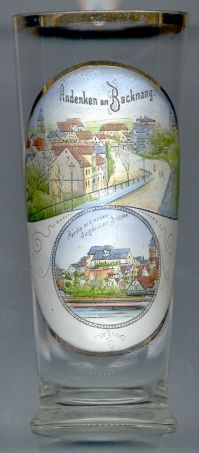

|
| DEUTSCHLAND | GERMANY |
| Bundesland: Baden-Württemberg | |
| Regierungsbezirk: Stuttgart | |
| Landkreis: Rems-Murr-Kreis |
 Backnang is situated at an elevation of 273 m on the river Murr in the nature preserve Schwäbisch-Fränkischer Wald of Baden-Württemberg.
The place was first mentioned in 1027 as Baccananc. In 1110 it came into possession of the margraves of Baden.
In 1237, Backnang obtained the status of a town. Since 1304 it is part of Württemberg.
Backnang is situated at an elevation of 273 m on the river Murr in the nature preserve Schwäbisch-Fränkischer Wald of Baden-Württemberg.
The place was first mentioned in 1027 as Baccananc. In 1110 it came into possession of the margraves of Baden.
In 1237, Backnang obtained the status of a town. Since 1304 it is part of Württemberg.
The  Stiftskirche Sankt Pankratius (Collegiate Church of St. Pancras) [bottom picture: centre]
was first mentioned in a papal document of 1116 referring to the monastery of the Augustinian Canons at Backnang.
Until 1122 it also served as parish church. The monastery was destroyed in 1235 by Margrave Hermann V of Baden, but was
rebuilt until 1246 by his sons Hermann VI and Rudolf I.
The monastery was converted to a secular collegiate monastery in 1477. In 1537 the church became Protestant and, with the exception of
the years 1548–52 and 1635–1648, remained so until today.
The oldest parts of the church date back to the Romanesque period. The eastern parts were rebuilt in Gothic style around 1500, the nave
was added in 1697. In 1929, the tombs of the early margraves of Baden (Hermann II and Hermann III), which until then
had been located in the chancel, were transferred to the crypt of the church.
Stiftskirche Sankt Pankratius (Collegiate Church of St. Pancras) [bottom picture: centre]
was first mentioned in a papal document of 1116 referring to the monastery of the Augustinian Canons at Backnang.
Until 1122 it also served as parish church. The monastery was destroyed in 1235 by Margrave Hermann V of Baden, but was
rebuilt until 1246 by his sons Hermann VI and Rudolf I.
The monastery was converted to a secular collegiate monastery in 1477. In 1537 the church became Protestant and, with the exception of
the years 1548–52 and 1635–1648, remained so until today.
The oldest parts of the church date back to the Romanesque period. The eastern parts were rebuilt in Gothic style around 1500, the nave
was added in 1697. In 1929, the tombs of the early margraves of Baden (Hermann II and Hermann III), which until then
had been located in the chancel, were transferred to the crypt of the church.
The  Stadtturm [bottom picture: right] was built in the mid-13th century. The tower was
heightened in 1614 and received half-timbered top part and roof in 1697. Today it holds the bells of the Collegiate Church.
Stadtturm [bottom picture: right] was built in the mid-13th century. The tower was
heightened in 1614 and received half-timbered top part and roof in 1697. Today it holds the bells of the Collegiate Church.
![[scale]](lineal.jpg)